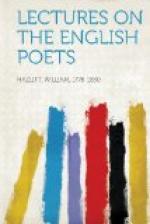“Come, gentle
Spring! ethereal Mildness! come,
And from the bosom
of yon dropping cloud,
While music wakes
around, veil’d in a shower
Of shadowing roses,
on our plains descend.”
Who, from such a flimsy, round-about, unmeaning commencement as this, would expect the delightful, unexaggerated, home-felt descriptions of natural scenery, which are scattered in such unconscious profusion through this and the following cantos? For instance, the very next passage is crowded with a set of striking images.
“And see
where surly Winter passes off
Far to the north,
and calls his ruffian blasts:
His blasts obey,
and quit the howling hill,
The shatter’d
forest, and the ravag’d vale;
While softer gales
succeed, at whose kind touch
Dissolving snows
in livid torrents lost,
The mountains
lift their green heads to the sky.
As yet the trembling
year is unconfirmed,
And Winter oft
at eve resumes the breeze,
Chills the pale
morn, and bids his driving sleets
Deform the day
delightless; so that scarce
The bittern knows
his time with bill ingulpht
To shake the sounding
marsh, or from the shore
The plovers when
to scatter o’er the heath,
And sing their
wild notes to the list’ning waste.”
Thomson is the best of our descriptive poets: for he gives most of the poetry of natural description. Others have been quite equal to him, or have surpassed him, as Cowper for instance, in the picturesque part of his art, in marking the peculiar features and curious details of objects;—no one has yet come up to him in giving the sum total of their effects, their varying influences on the mind. He does not go into the minutiae of a landscape, but describes the vivid impression which the whole makes




